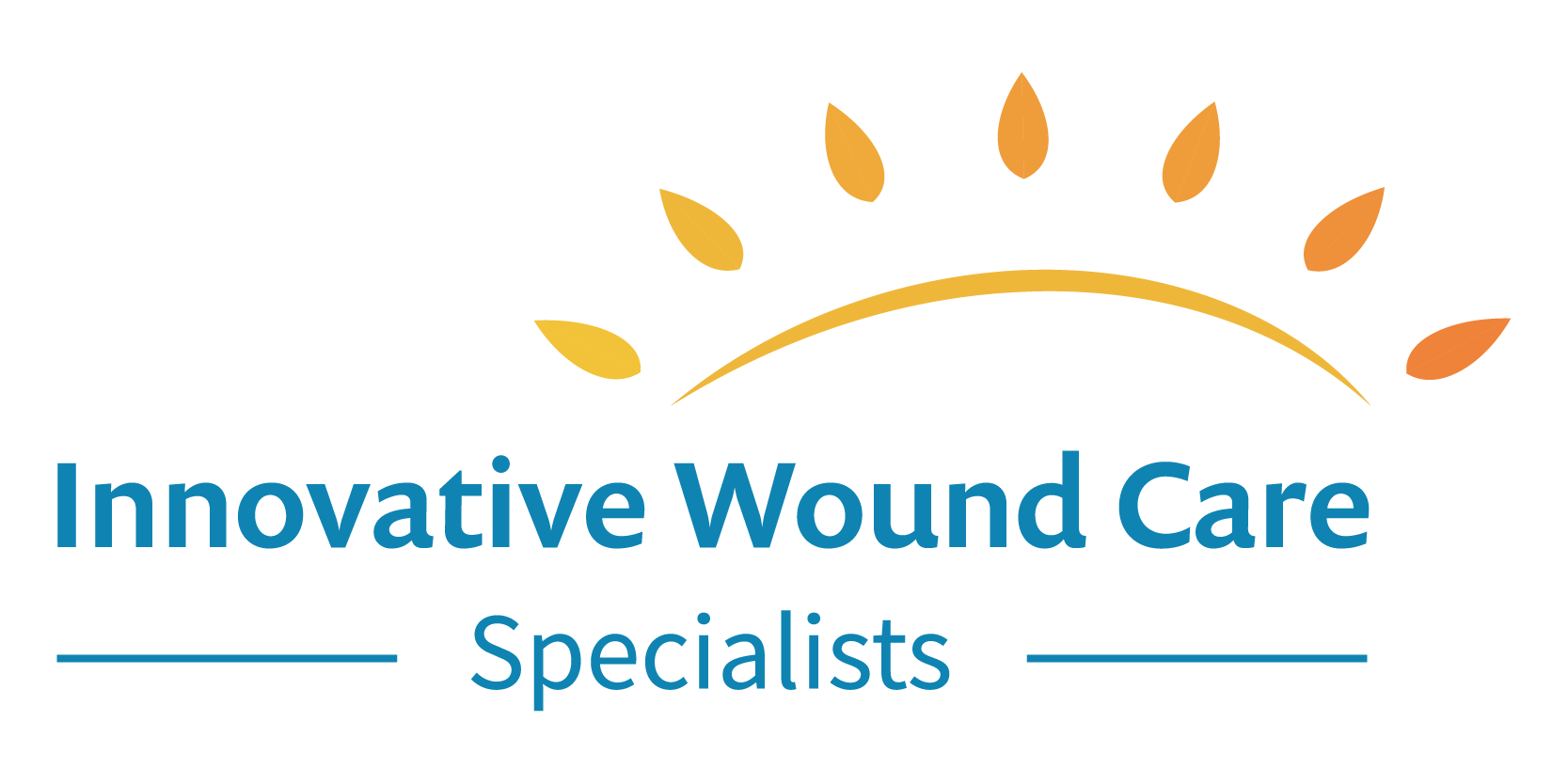Pressure Injuries
Pressure Injuries
Learn how modern, evidence-based treatments at Innovative Wound Care Specialists can heal your pressure injuries.
Pressure injuries, also known as pressure ulcers, bedsores, or decubitus ulcers, are localized damage to the skin and underlying tissue. Pressure injuries are caused when pressure cuts off the blood supply to the skin for a prolonged period of time. This lack of blood flow leads to injury of skin tissue.
These wounds typically occur over bony areas due to prolonged pressure or friction. Recognizing the symptoms and understanding the causes of pressure injuries are crucial for effective prevention and management.
Continue reading to learn more about pressure injury causes, symptoms, and treatment options.
Start Treatment Today
Pressure injuries significantly affect patients physically and emotionally. They cause severe pain, increase the risk of infections, and often result in prolonged healing times. This can lead to reduced mobility, further complicating a patient’s health by fostering a sedentary lifestyle.
Emotionally, pressure injuries can be devastating, leading to depression and anxiety due to chronic pain and the ongoing burden of wound care. Additionally, they diminish the quality of life by limiting independence and social interaction.

Pressure injuries are classified into several stages, each with its own set of symptoms:
Stage 1: Non-Blanchable Erythema
- Redness on the skin that does not turn white (blanch) when pressed.
- The area may feel warmer or cooler than the surrounding skin.
- Pain or discomfort in the affected area.
- Swelling and hardness compared to adjacent tissue.
Stage 2: Partial-Thickness Skin Loss
- Shallow, open wound with a red-pink wound bed, without slough.
- May present as an intact or open/ruptured serum-filled blister.
- The area may exhibit edema and some drainage.
Stage 3: Full-Thickness Skin Loss
- Full-thickness skin tissue loss, subcutaneous fat may be visible, but bone, tendon, or muscle are not exposed.
- Possible presence of slough (yellow, tan, gray, green, or brown).
- Pain may decrease as nerve damage progresses, but the area remains tender.
- Possible tunneling or undermining of surrounding tissue.
Stage 4: Full-Thickness Tissue Loss
- Full-thickness tissue loss with exposed bone, tendon, or muscle.
- Presence of slough or eschar (black, brown, or tan tissue) on some parts of the wound bed.
- Pain might be less noticeable due to extensive tissue damage and nerve damage.
- Often includes undermining and tunneling of surrounding tissue.
Unstageable: Depth Unknown
- Full-thickness skin or tissue loss where the base of the ulcer is covered by slough and/or eschar.
- The wound bed is obscured by necrotic tissue.
- Varies depending on the extent of tissue damage.
- The true depth and stage cannot be determined until the slough and/or eschar is removed.
Pressure injuries result from prolonged pressure on the skin, often in combination with other factors:
- Sustained Pressure
Continuous pressure on one area of the body impedes blood flow to the skin and underlying tissues. The damaging pressure can be minimal over a long period or great pressure over a short period. Lack of blood flow leads to tissue damage to the area. Common sites are bony areas like heels, ankles, hips, and tailbone. - Shear
Shear forces occur when the skin moves one way and the underlying bone moves in the opposite direction. Causes of shear can include sliding down in a bed or chair, especially when the head of the bed is elevated. Transferring a patient from the bed to a wheelchair can also potentially lead to shear injuries. - Friction
Friction occurs when the skin rubs against a surface, causing abrasion and weakening the skin. The friction can create shear strain in the deeper tissues, damaging them and leading to additional pressure injuries. This can happen with frequent repositioning or dragging on bed linens.\ - Moisture
Excess moisture from sweat, urine, or wound drainage can macerate the skin, making it more susceptible to damage. Some causes of excess moisture include incontinence, wound exudate, and excessive sweating. - Poor Nutrition and Hydration
Just like proper nutrition and hydration is essential for daily functions, it is also vital for proper wound healing. So, inadequate intake of nutrients and fluids can weaken the skin and delay healing. Conditions like malnutrition, dehydration, and certain medical conditions can impair nutrient absorption. - Reduced Mobility
Limited movement reduces the ability to relieve pressure on susceptible areas. Continuous pressure, though mild, can lead to pressure injuries. Conditions like paralysis, sedation, prolonged bed rest, or use of restraints can prompt pressure injuries from reduced mobility.
It’s crucial to seek medical attention if you notice any signs or experience any symptoms of a pressure injury. Early intervention can prevent complications and ensure effective treatment. An accurate diagnosis, customized treatment plan, pain management, and regular visits to the doctor are all part of the pressure wound healing process.
If you or a loved one are experiencing symptoms of a pressure injury, contact Innovative Wound Care Specialists today to schedule a wound assessment and personalized treatment plan.

Effective prevention and management of pressure injuries require early recognition of symptoms and a thorough understanding of their causes. By addressing the risk factors and implementing proactive care strategies, healthcare providers can significantly reduce the incidence and severity of pressure injuries.
At Innovative Wound Care Specialists, the evaluation of pressure injuries is a comprehensive process that involves several key steps to ensure accurate diagnosis and effective treatment planning. Our approach is guided by the latest evidence-based practices and clinical guidelines to provide the highest quality care.
Evaluation typically involves:
Patient Medical History and Risk Assessment
Physical Examination of Skin
Staging Pressure Injuries (Stages 1-4, Unstageable, or Deep Tissue Injury)
Wound Assessment, Measurement, and Exudate Evaluation
Signs of Infection and Microbiological Testing
Nutritional and Hydration Assessment
Pain Evaluation During Rest and Wound Care Procedures
Mobility and Functional Evaluation
This thorough evaluation process allows our specialists to develop a tailored treatment plan that addresses the unique needs of each patient, ensuring optimal outcomes and improved quality of life.
Patient and wound assessments are essential components of the wound care process, playing a crucial role in understanding the patient’s overall health, identifying factors that may impact wound healing, and tailoring an effective treatment plan.
Assessing the patient’s overall health, medical history, and lifestyle factors helps healthcare professionals at IWC understand potential underlying conditions that may affect wound healing. Factors that may affect wound healing include diabetes, vascular disease, nutritional status, and immune function.
Treating pressure injuries involves a multifaceted approach that aims to promote healing, prevent complications, and improve patient comfort. The choice of treatment depends on the stage of the pressure injury, the overall health of the patient, and the presence of any underlying conditions.
At Innovative Wound Care Specialists, we provide a comprehensive range of advanced treatments to promote effective wound healing and enhance overall well-being. From Compression Dressings to Hyperbaric Oxygen Therapy (HBOT), our goal is to deliver advanced treatments and compassionate care for every patient’s unique needs to promote long term healing and prevent recurrence with the help of our professional wound specialists.
Chronic wounds can cause patients to suffer and affect mobility. While most wounds heal quickly, pressure injuries may not heal or fail to improve for weeks and can cause severe problems if left untreated.
Wound Care May Include . . .
Compression Dressings & Advanced Wound Dressings – We offer a variety of innovative wound dressings, including those with antimicrobial properties, moisture control, and pressure relief features.
Laboratory and Vascular Evaluation – Monitor patient’s peripheral artery disease (PAD) and its effect on supplying blood to wounded tissues.
Cellular or Tissue-Based Products – Utilizing bioengineered skin grafts and substitutes to promote faster healing and tissue regeneration.
Wound Measurement and Photographs – To monitor wound progression and wound healing.
Hyperbaric Oxygen Therapy (HBOT) – Enhancing oxygen supply to the affected area to accelerate wound healing and combat infection.
Surgical Procedures and Support – Assisting in wound closure, infection control, tissue removal or repair, promotion of granulation tissue, reducing tension on wounds, enhancing blood supply, and management of complications.
Negative Pressure Wound Therapy (NPWT) – Using controlled suction to remove exudate, reduce edema, and improve blood flow to the wound.
Prosthetic and Pressure Relief Assistance – To reduce pressure on the ulcer, we provide specialized footwear and custom orthotics, designed to redistribute weight and minimize friction.
Debridement – Removal of dead, damaged, or infected tissue by surgical or other means to improve the healing potential of the remaining healthy tissue.
At Innovative Wound Care Specialists, we are dedicated to transforming lives through expert care and advanced treatments for pressure injuries.
If you or a loved one is struggling with a pressure injury, don’t struggle through the pain any longer. Contact Innovative Wound Care Specialists today to schedule a consultation with one of our professional wound specialists, and take the first step towards effective, comprehensive wound care. Your journey to healing starts here.
Contact us by phone (810) 600-2030 or email info@innovativewoundspecialists.com and our friendly staff will assist you every step of the way. Don’t wait any longer—get started today! We’re here to help.
